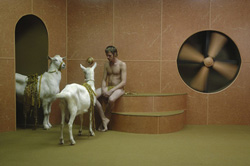"Of all the things that oppress me, this sense of the evil working of nature herself - my disgust at her barbarity - clumsiness - darkness - bitter mockery of herself - is the most desolating." John Ruskin.
The white faced heron looks at us from a landscape of succulent grass, the sky behind a fuzzy, gentle blue. Unfortunately that's all it can do because it's actually dead, stuffed and mounted in an imitation of a natural scene so drained of life it lacks even pathos. The scene, perhaps in a museum, an installation or set up for the camera, is an artwork by Hayden Fowler called Monoculture [2001], and it suggests a rather disquieting notion - nature is blank. When we try to derive meaning from nature, the question is do we see in it something apart from ourselves, something that we can define, classify or contextualize with a level of objectivity - or are we actually only experiencing a reflection of our own sublimated desires? This question goes to the root of our collective relationship with science and religions, to ethical questions of our responsibilities to the planet, and may seem so large and complex to appear utterly diffuse. Yet we are reminded of this vexatious relationship all the time - with news of vast ice shelves in Antarctica breaking up, of record early spring heat waves, of unprecedented levels of carbon in the atmosphere. Our troubled relationship with nature is particularly acute. The work of Hayden Fowler tackles these big questions, looking not for answers, but for clues about how we define ourselves in contrast to this concept we call 'nature'.
Many of Fowler's works look at the way natural features co-exist within a built environment. They can take on literal renderings. Sculptures such as Platform [2001] - with its elaborately constructed wooden scaffolding for a rectangle of turf - or Recalling Lost Utopia [2002] with its inverted cone of grass sitting in a darkened gallery space - spell out the isolation of 'natural textures' as they are often found in architectural interiors. Who hasn't felt the odd frisson of recognition - and then disappointment - upon seeing, say, river rocks arranged in the foyer of an office block, or a wood grain feature wall in a bar that turns out to be wallpaper? Fowler's work plays with these levels of emotional recognition. The installation Postcards from Utopia [2003] took this type of contrasting to an extreme, creating a discontinuous narrative of forms – a platform, real grass, real naked human body, a billboard-like structure with an image of a stuffed seal and soda can on a fake beach, all of it arranged as if encountered in a department store.
Fowler's work can also delve into more mysterious and metaphoric realms. His recent DVD work Goat Odyssey [2006] posits a hermetic world populated by two brocaded goats who encounter each other in a set that recalls the post apocalyptic sterility of George Lucas's THX 1138 [1970] mixed with the hedonistic excesses of Tinto Brass's Caligula [1979]. Indeed, the carnality of the exotic is compounded in Fowler's Nursling [2006], a series of stills that accompany Goat Odyssey. By adding a near naked man to the narrative, Fowler suggests the fraudulent theatricality of Victorian-era history painting transposed into an ambiguous sci-fi sex narrative. Fowler uses his goats as stand-ins for humans, innocent as they are to our gaze, but like the citizens of a zoological garden, subservient to a greater imaginary narrative imposed by their captors. This idea is implicitly political and Fowler does not shy away from addressing it. His recent DVD work White Australia [2005] makes a statement about our country - driven like rats through a maze, our movements spelling out a secret message to anyone willing to decode it. His DVD White Cock [2005] explored similar territory, collapsing the formal qualities of 'art' history with a mocking visual pun on flagrant masculinity.
Fowler's work might seem to infer a bleak view of our relationship to the natural world but it's far more hopeful than it might at first appear. His critique proposes that what we call 'nature' is a part of our fragmented, decontextualised experience of everyday life. If we could see the human built world and that of nature as one and the same thing, then we might begin to understand and reconcile them. As the quote above from the great 19th Century art critic John Ruskin demonstrates, the reflection of ourselves that we find 'out there' provokes a deep and troubling ambivalence, yet at the same time we find within it great possibility. "Go to nature in all singleness of heart, rejecting nothing and selecting nothing," wrote Ruskin, for then we might find redemption.
Andrew Frost
GBK catalogue, October 2006.

image: Monoculture, 2001

image: Nursling, 2006

image: White Cock, 2005
